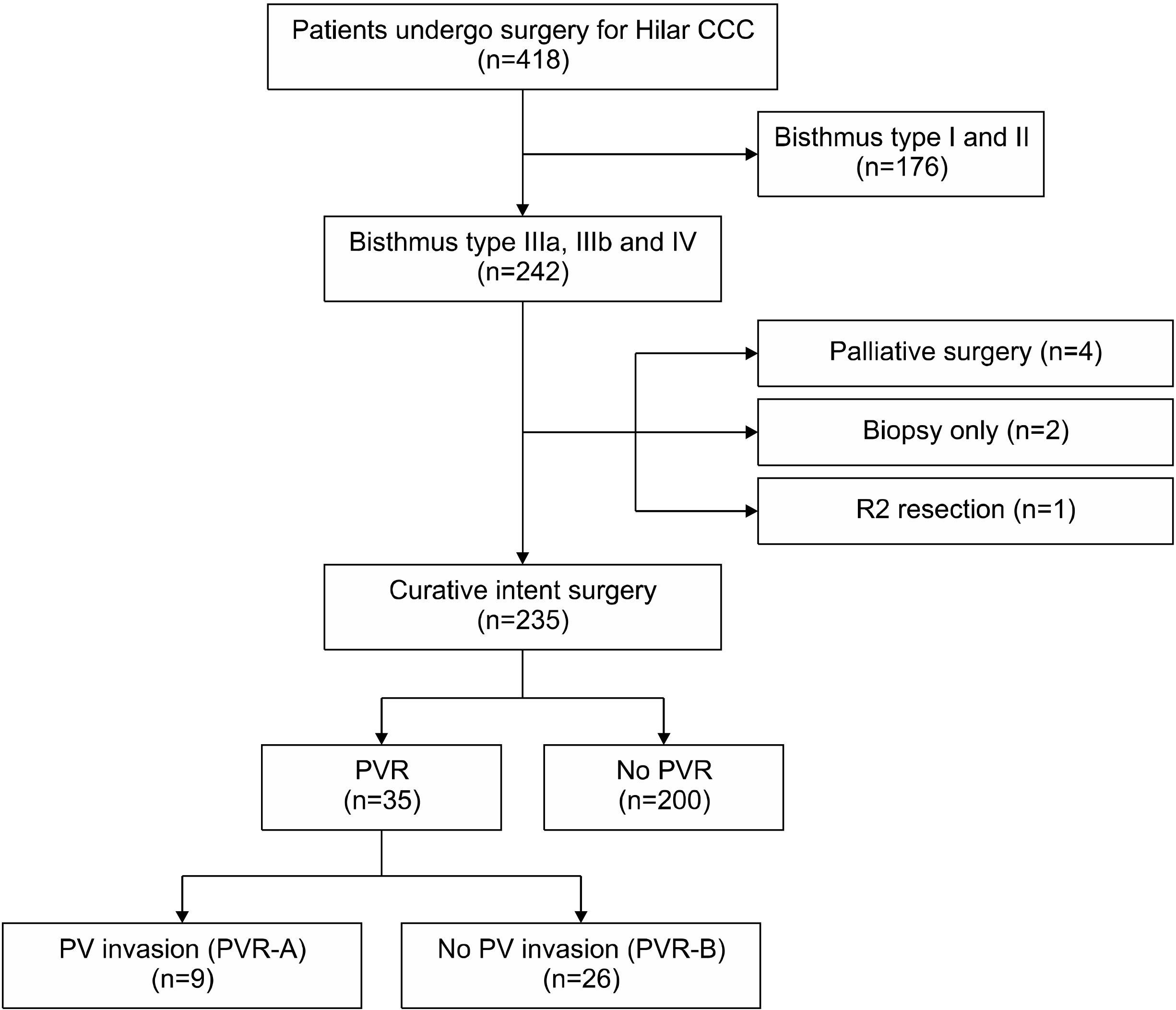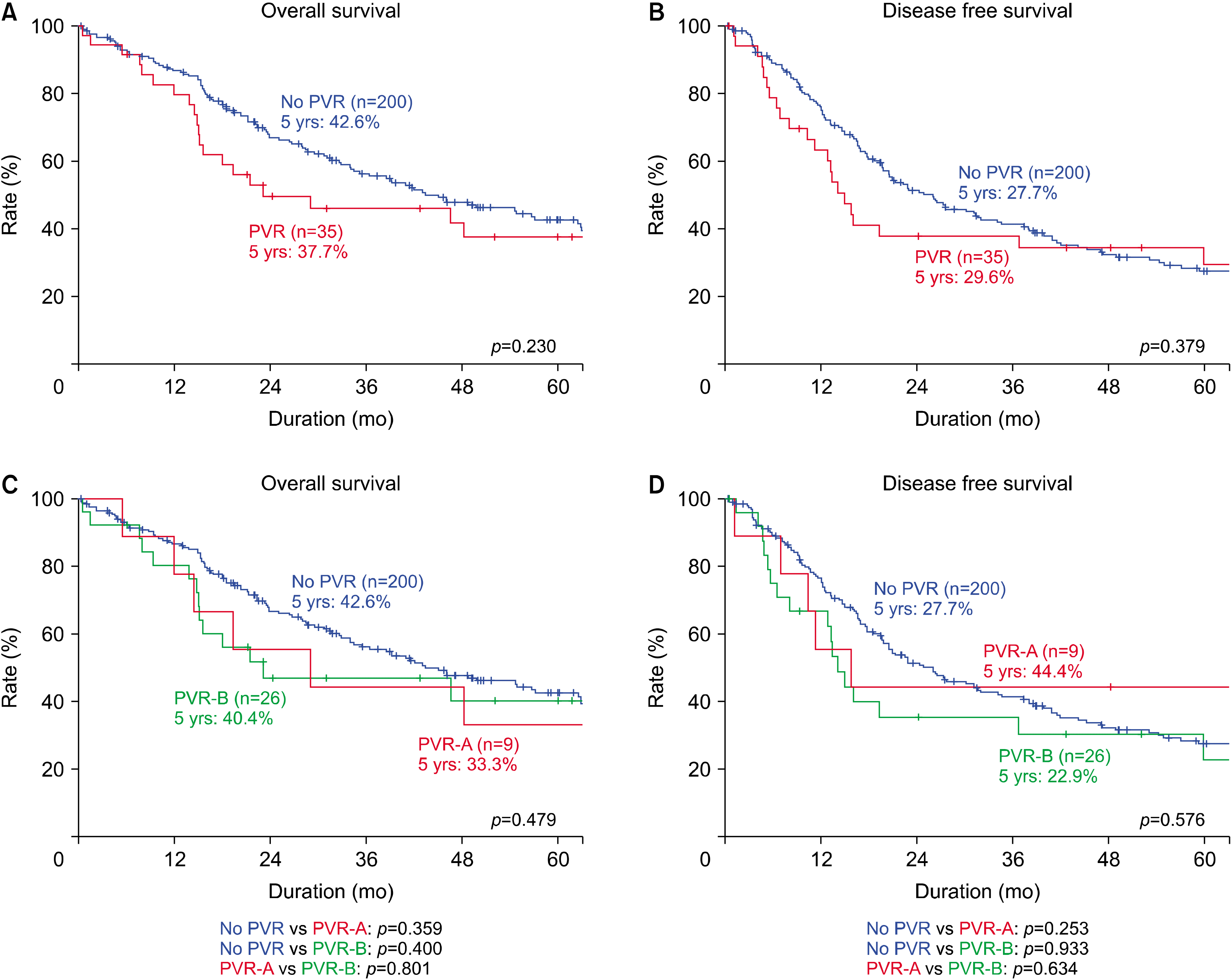3. Seyama Y, Kubota K, Sano K, Noie T, Takayama T, Kosuge T, et al. 2003; Long-term outcome of extended hemihepatectomy for hilar bile duct cancer with no mortality and high survival rate. Ann Surg. 238:73–83. DOI:
10.1097/01.SLA.0000074960.55004.72. PMID:
12832968. PMCID:
PMC1422671.

4. Sano T, Shimada K, Sakamoto Y, Yamamoto J, Yamasaki S, Kosuge T. 2006; One hundred two consecutive hepatobiliary resections for perihilar cholangiocarcinoma with zero mortality. Ann Surg. 244:240–247. DOI:
10.1097/01.sla.0000217605.66519.38. PMID:
16858186. PMCID:
PMC1602147.

6. Blechacz B, Gores GJ. 2008; Cholangiocarcinoma: advances in pathogenesis, diagnosis, and treatment. Hepatology. 48:308–321. DOI:
10.1002/hep.22310. PMID:
18536057. PMCID:
PMC2547491.

8. Deoliveira ML, Schulick RD, Nimura Y, Rosen C, Gores G, Neuhaus P, et al. 2011; New staging system and a registry for perihilar cholangiocarcinoma. Hepatology. 53:1363–1371. DOI:
10.1002/hep.24227. PMID:
21480336.

9. de Jong MC, Marques H, Clary BM, Bauer TW, Marsh JW, Ribero D, et al. 2012; The impact of portal vein resection on outcomes for hilar cholangiocarcinoma: a multi-institutional analysis of 305 cases. Cancer. 118:4737–4747. DOI:
10.1002/cncr.27492. PMID:
22415526.
11. Ebata T, Nagino M, Kamiya J, Uesaka K, Nagasaka T, Nimura Y. 2003; Hepatectomy with portal vein resection for hilar cholangiocarcinoma: audit of 52 consecutive cases. Ann Surg. 238:720–727. DOI:
10.1097/01.sla.0000094437.68038.a3. PMID:
14578735. PMCID:
PMC1356151.
12. Miyazaki M, Kato A, Ito H, Kimura F, Shimizu H, Ohtsuka M, et al. 2007; Combined vascular resection in operative resection for hilar cholangiocarcinoma: does it work or not? Surgery. 141:581–588. DOI:
10.1016/j.surg.2006.09.016. PMID:
17462457.

13. Hirano S, Kondo S, Tanaka E, Shichinohe T, Tsuchikawa T, Kato K. 2009; No-touch resection of hilar malignancies with right hepatectomy and routine portal reconstruction. J Hepatobiliary Pancreat Surg. 16:502–507. DOI:
10.1007/s00534-009-0093-7. PMID:
19360368.

14. Hirano S, Kondo S, Tanaka E, Shichinohe T, Tsuchikawa T, Kato K, et al. 2010; Outcome of surgical treatment of hilar cholangiocarcinoma: a special reference to postoperative morbidity and mortality. J Hepatobiliary Pancreat Sci. 17:455–462. DOI:
10.1007/s00534-009-0208-1. PMID:
19820891.

15. Hemming AW, Mekeel K, Khanna A, Baquerizo A, Kim RD. 2011; Portal vein resection in management of hilar cholangiocarcinoma. J Am Coll Surg. 212:604–613. discussion 613–616. DOI:
10.1016/j.jamcollsurg.2010.12.028. PMID:
21463797.

16. Song SC, Choi DW, Kow AW, Choi SH, Heo JS, Kim WS, et al. 2013; Surgical outcomes of 230 resected hilar cholangiocarcinoma in a single centre. ANZ J Surg. 83:268–274. DOI:
10.1111/j.1445-2197.2012.06195.x. PMID:
22943422.

17. Edge SB. 2010. AJCC cancer staging manual. 7th ed. Springer;New York:
18. Dindo D, Demartines N, Clavien PA. 2004; Classification of surgical complications: a new proposal with evaluation in a cohort of 6336 patients and results of a survey. Ann Surg. 240:205–213. DOI:
10.1097/01.sla.0000133083.54934.ae. PMID:
15273542. PMCID:
PMC1360123.
19. Kawarada Y, Das BC, Naganuma T, Tabata M, Taoka H. 2002; Surgical treatment of hilar bile duct carcinoma: experience with 25 consecutive hepatectomies. J Gastrointest Surg. 6:617–624. DOI:
10.1016/S1091-255X(01)00008-7.

20. Chen W, Ke K, Chen YL. 2014; Combined portal vein resection in the treatment of hilar cholangiocarcinoma: a systematic review and meta-analysis. Eur J Surg Oncol. 40:489–495. DOI:
10.1016/j.ejso.2014.02.231. PMID:
24685155.

21. Bai T, Chen J, Xie ZB, Ma L, Liu JJ, Zhu SL, et al. 2015; Combined portal vein resection for hilar cholangiocarcinoma. Int J Clin Exp Med. 8:21044–21052.
22. Kloek JJ, Ten Kate FJ, Busch OR, Gouma DJ, van Gulik TM. 2008; Surgery for extrahepatic cholangiocarcinoma: predictors of survival. HPB (Oxford). 10:190–195. DOI:
10.1080/13651820801992575. PMID:
18773053. PMCID:
PMC2504374.

24. Muñoz L, Roayaie S, Maman D, Fishbein T, Sheiner P, Emre S, et al. 2002; Hilar cholangiocarcinoma involving the portal vein bifurcation: long-term results after resection. J Hepatobiliary Pancreat Surg. 9:237–241. DOI:
10.1007/s005340200025. PMID:
12140613.

25. Song GW, Lee SG, Hwang S, Kim KH, Cho YP, Ahn CS, et al. 2009; Does portal vein resection with hepatectomy improve survival in locally advanced hilar cholangiocarcinoma? Hepatogastroenterology. 56:935–942.
26. Nagino M, Nimura Y, Nishio H, Ebata T, Igami T, Matsushita M, et al. 2010; Hepatectomy with simultaneous resection of the portal vein and hepatic artery for advanced perihilar cholangiocarcinoma: an audit of 50 consecutive cases. Ann Surg. 252:115–123. DOI:
10.1097/SLA.0b013e3181e463a7. PMID:
20531001.




 PDF
PDF Citation
Citation Print
Print





 XML Download
XML Download